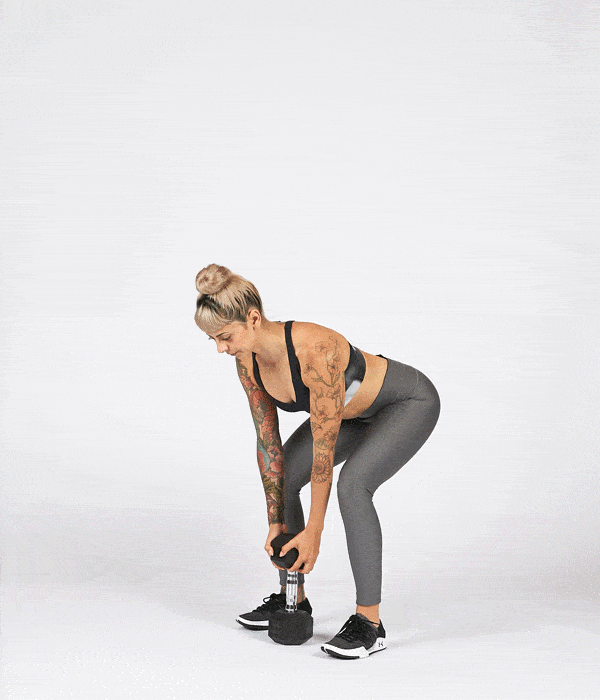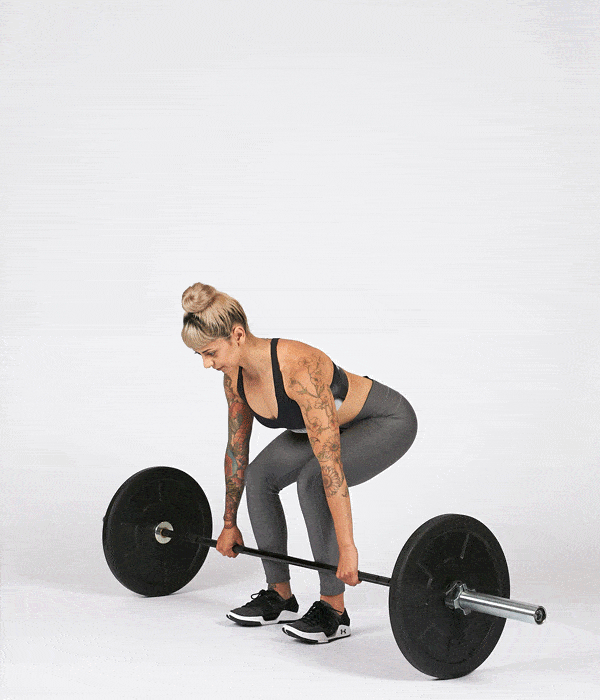The deadlift is a unique exercise. It’s called the “deadlift” because the exercise starts from a dead stop. Most exercises, like the pushup or squat, start with some motion. You have to go down before you come up. On the deadlift you’re still at the beginning, then your body has to generate enough power to lift the weight up.
Lower back pain is one of the most common complaints among weightlifters, according to a 2019 study in Cogent Medicine. Correct technique can save you from pain and injury. The most important thing to you can do to keep your spine healthy is avoid rounding your back as you deadlift.
Whether you’re struggling with technique or pain, or you need a greater challenge, you should try different deadlift variations.
DUMBBELL DEADLIFT

When you’re just learning the deadlift, there’s no need to use fancy equipment or heavy weights. Simply learn the movement. Dumbbells are readily available and easier to lift than a barbell because they’re lighter and more forgiving if you are working on your technique.
The move: Take a dumbbell and place it on the floor with the handle facing vertically. Stand over the dumbbell with your feet slightly wider than shoulder-width and toes pointed out. Stick your butt back and bend your knees slightly. As you go down, keep your chest up and back flat.
Grip the top of the dumbbell with both hands and lift it off the ground. Stand all the way up without bending your arms. To put it down, stick your butt back again, keep your back flat and bend your knees slightly.
KETTLEBELL DEADLIFT

This exercise is almost identical to the dumbbell deadlift, but you’ll use a kettlebell instead.
The move: Start with the kettlebell on the ground. Stand over the kettlebell. The handle should be in line with your ankles. Stick your butt back, keep your chest up and squat down until you can grab the handle. Use your legs to get down to the kettlebell instead of bending too much at the back. Grab the handle with both hands and drive through your heels while standing up. Stand all the way up at the top with your elbows straight. To put the kettlebell down, reverse the steps by sticking your butt back, keeping your chest puffed out and spine straight.
SUITCASE DEADLIFT

Heavy grocery bags or suitcases at the airport are awkward to carry around, but you can prepare your body for these mundane activities with the suitcase deadlift. The movement itself is a hybrid between a squat and a deadlift.
The move: Start with two dumbbells on the ground. They should be outside your feet and your feet should be shoulder-width apart. The handles of the kettlebells should be parallel with your feet. Squat down, sticking your butt back, until you can grab the handles. Stand up like you’re lifting two suitcases to walk through the airport.
Remember to press through your heels as you stand up and as you lower the weights back down to the ground. If you can’t lower the weight to the ground without rounding your back, don’t go all the way down. Squat as low as you can without your back rounding, then stand back up to complete the repetition.
DOUBLE KETTLEBELL DEADLIFT

Much like the suitcase deadlift, you’ll need two kettlebells of the same size for this exercise.
The move: This time, stand with your feet wider than your shoulders and toes pointed slightly out. The kettlebells should be between your feet. Stick your butt back, keep your back flat and squat down until you can grab both handles. To lift, flatten your back, sit back into your heels and stand up, leaning back slightly. Stand all the way up, keeping the kettlebells in front of you. Then, reverse the movement to go back down.
RACK PULL

The barbell can be intimidating, but this exercise is a good step between kettlebell and barbell deadlifts. It’ll help you build confidence, strengthen your lower back and leg muscles and improve your grip. You’ll need a power rack or squat rack to do it.
The move: Set the pins of the rack to mid-shin height. Put the bar on the pins. Walk up to the bar so your shins are touching it. Stick your butt back and be careful not to press into the bar with your shins. This keeps your knees from bending too much, which works your hamstrings more. Keep your back flat and lift the bar. Press your hips through at the top of the movement. Reverse the steps to put the bar back on the pins. Pause for a second and repeat.
BARBELL CONVENTIONAL DEADLIFT

The move: For the conventional deadlift, walk up to the bar with your feet shoulder-width apart. Your shins should be an inch from the bar. Stick your butt back and grip the bar with your hands outside your legs, further than shoulder-width apart. Flatten your back, then drive your heels into the ground to lift the weight. Set the weight down by sticking your butt back from the top and bending your knees once the bar goes below your knees. Set the bar down completely and pause for a second before completing another repetition.
DEFICIT DEADLIFT

The most difficult part of the deadlift is the first portion, lifting it off the ground. Once it’s traveling up, it gets gradually easier until you’re fully upright. The deficit deadlift extends the bottom portion, making the deadlift much harder without adding any weight.
The move: Put a weight plate on the ground in the center of the barbell. Stand on it and perform a conventional deadlift. Don’t use this exercise every deadlift workout, because it can be very taxing on your lower back.
BARBELL SUMO DEADLIFT

Barbell deadlifts from the ground are some of the most complex weightlifting movements. You need to make sure your form is on point to avoid injuries. Some people find the sumo deadlift more comfortable and some prefer the conventional style with feet close together. Try both and stick with the one you prefer.
The move: Start with a barbell on the ground. Use bumper plates so the bar is around low- to mid-shin height. For the sumo deadlift, walk up to the bar until your shins touch. Your feet should be half a foot wider than shoulder-width apart. Point your toes out slightly.
Bend your knees and stick your butt back while reaching for the bar. Grab it with both hands. Your knuckles should be facing the wall in front of you and your hands should be directly under your shoulders. Lean back, drop your butt down, stick your chest up, then stand up and drive through your heels. To put it back down, stick your butt back and bend your legs.
TRAP BAR DEADLIFT
You’ll need a specialized bar for this exercise, called a trap bar. It’s a large, metal hexagon with handles. Make sure you use bumper plates, which have a standard height, rather than smaller plates which may be too small. If you don’t have a trap bar, do a dumbbell deadlift.
The move: Stand inside the trap bar. Your feet should be shoulder-width apart. Stick your butt back and bend your knees until you can grab the handles on the sides. Your hands should be in the middle of the handles. Flatten your back by sticking your chest out. Then, drive through your heels and stand up with the weight.
Set the trap bar down by squatting down with the weight. Use your legs more than your back. Don’t bounce the weight off the floor as you go down. Rather, place the bar on the ground and let it rest for a moment before lifting again. Try to put the bar down and pick it up from the same spot every time.




